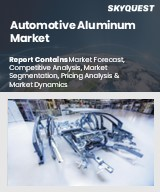
자동차용 알루미늄 세계 시장 규모는 2023년 272억 달러로 평가되었고, 예측 기간(2025-2032년) CAGR은 9.1%로, 2024년 296억 8,000만 달러에서 2032년에는 595억 7,000만 달러로 성장할 전망입니다.
세계 자동차용 알루미늄 시장은 엄격한 환경 규제와 연료비 상승으로 인한 저연비 차량에 대한 수요 증가가 주요 요인으로 작용하고 있습니다. 자동차 제조업체들은 연비 향상과 CO2 배출량 최소화를 위해 알루미늄과 같은 경량 소재로의 전환을 추진하고 있습니다. 이 소재는 차량 무게를 크게 줄이고 연비를 향상시키며 배출가스를 줄이기 위해 차체 패널과 프레임 등 자동차에 필수적인 부품에 대한 채택이 증가하고 있습니다. 또한, 급성장하는 전기자동차(EV) 시장은 이러한 추세를 더욱 가속화시키고 있습니다. 알루미늄의 내식성과 내구성은 EV 차체 구조에 알루미늄을 선호하게 만들었으며, 이는 진화하는 자동차 분야에서 알루미늄의 중요한 역할을 확고히 하고 있습니다.
Global Automotive Aluminum Market size was valued at USD 27.2 billion in 2023 and is poised to grow from USD 29.68 billion in 2024 to USD 59.57 billion by 2032, growing at a CAGR of 9.1% during the forecast period (2025-2032).
The global automotive aluminum market is primarily fueled by the increasing demand for fuel-efficient vehicles, shaped by strict environmental regulations and rising fuel costs. Automakers are under pressure to enhance fuel efficiency and minimize CO2 emissions, prompting a shift towards lightweight materials like aluminum. This material significantly reduces vehicle weight, thereby improving fuel economy and lowering emissions, which leads to its rising adoption in essential automotive components like body panels and frames. Additionally, the burgeoning electric vehicle (EV) market further accelerates this trend, as lighter vehicles optimize battery efficiency and driving range. Aluminum's corrosion resistance and durability make it a preferred choice for EV body structures, solidifying its essential role in the evolving automotive sector.
Top-down and bottom-up approaches were used to estimate and validate the size of the Global Automotive Aluminum market and to estimate the size of various other dependent submarkets. The research methodology used to estimate the market size includes the following details: The key players in the market were identified through secondary research, and their market shares in the respective regions were determined through primary and secondary research. This entire procedure includes the study of the annual and financial reports of the top market players and extensive interviews for key insights from industry leaders such as CEOs, VPs, directors, and marketing executives. All percentage shares split, and breakdowns were determined using secondary sources and verified through Primary sources. All possible parameters that affect the markets covered in this research study have been accounted for, viewed in extensive detail, verified through primary research, and analyzed to get the final quantitative and qualitative data.
Global Automotive Aluminum Market Segments Analysis
Global Automotive Aluminum Market is segmented by Application, Product Form, Vehicle Type and region. Based on Application, the market is segmented into Powertrain, Chassis & Suspension and Car Body. Based on Product Form, the market is segmented into Cast Aluminum, Rolled Aluminum and Extruded Aluminum. Based on Vehicle Type, the market is segmented into Passenger Car, LCV and HCV. Based on region, the market is segmented into North America, Europe, Asia Pacific, Latin America and Middle East & Africa.
Driver of the Global Automotive Aluminum Market
The global automotive aluminum market is significantly influenced by the increasing implementation of stringent environmental regulations across various regions. Governments are setting higher fuel efficiency standards and demanding reductions in carbon dioxide emissions, which compel automotive manufacturers to seek materials that enhance sustainability. In this context, aluminum emerges as a preferred choice due to its lightweight properties, which contribute to decreased vehicle weight. This reduction not only improves overall fuel efficiency but also helps in meeting strict emission targets, making aluminum a vital material in the pursuit of eco-friendly automotive solutions. The demand for aluminum in vehicles reflects the industry's shift towards more sustainable practices.
Restraints in the Global Automotive Aluminum Market
The global automotive aluminum market faces challenges due to the insufficient advanced recycling infrastructure in various regions. This limitation hampers effective recycling efforts, resulting in a greater reliance on primary aluminum production, which in turn elevates costs and raises environmental concerns. The inability to fully capitalize on aluminum's recyclability undermines its sustainability advantages within the automotive sector. Consequently, the lack of proper recycling facilities not only impacts the economic aspects of aluminum use but also detracts from the overall environmental benefits that could be achieved, creating a significant barrier to growth and innovation in the market.
Market Trends of the Global Automotive Aluminum Market
The global automotive aluminum market is experiencing a notable trend toward increased demand for lightweight materials, driven largely by automakers' efforts to enhance fuel efficiency and comply with stringent emission regulations. Aluminum offers a compelling advantage, as its lightweight yet robust properties allow manufacturers to reduce overall vehicle weight, leading to improved performance and lower fuel consumption. This trend is particularly evident in both internal combustion engine vehicles and the rapidly growing electric vehicle segment, where every kilogram saved translates into enhanced range and efficiency. As sustainability concerns escalate, aluminum's adaptability and recyclability further solidify its pivotal role in the future of automotive design.